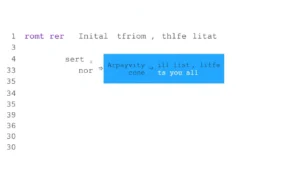IndusInd Bank Stock: Buy, Sell, or Hold After Q1 Results?
- THE MAG POST

- Aug 14
- 10 min read

Following IndusInd Bank's Q1 results, the stock saw a 2% rise, so let's consider if you should buy, sell, or hold. The IndusInd Bank stock's performance post-Q1 needs a thorough look, so we can guide your investment decisions. We will consider financial health and brokerage views, so you can get a clear picture. By analyzing these key points, you'll be better equipped to make smart moves with IndusInd Bank stock. Let's dive in and make sense of it all together!
Following the release of its Q1 results, IndusInd Bank stock experienced a 2% surge, prompting investors to evaluate whether to buy, sell, or hold. This analysis delves into the IndusInd Bank stock performance and provides insights to guide investment decisions. The initial surge in IndusInd Bank stock price reflects market reaction to the reported Q1 results, which necessitates a detailed examination to determine the underlying factors driving this movement. Understanding the nuances of the IndusInd Bank stock requires analyzing various parameters, including financial performance, asset quality, and brokerage opinions, to make an informed decision. As investors weigh their options, a comprehensive review of the IndusInd Bank stock is essential to navigate the complexities of the market and optimize their investment strategies.
Analyzing IndusInd Bank Stock Performance After Q1 Results
The IndusInd Bank stock saw a 2% increase following the release of its Q1 results, reaching an intra-day high of ₹819 per share on the BSE. This initial reaction highlights the market's response to the reported figures, prompting a deeper analysis of the IndusInd Bank stock. While the stock price showed positive movement, it is crucial to understand the underlying factors contributing to this surge. Investors are keen to assess whether this increase is sustainable and reflects the true potential of the IndusInd Bank stock. Examining the bank's financial performance, asset quality, and future prospects is essential for determining the long-term viability of the IndusInd Bank stock. A comprehensive analysis of the IndusInd Bank stock is necessary to make informed investment decisions and navigate the market effectively.
Despite the initial positive movement, a closer look at the IndusInd Bank stock reveals a more nuanced picture. The bank's Q1 results indicated a 72% year-on-year decline in net profit, raising concerns about its overall financial health. This decline in profitability has led brokerages to maintain varied stances on the IndusInd Bank stock, reflecting the uncertainty surrounding its future performance. Investors need to carefully consider these factors before making any decisions regarding the IndusInd Bank stock. The long-term potential of the IndusInd Bank stock depends on its ability to address the challenges highlighted in the Q1 results and improve its financial metrics. A thorough evaluation of the IndusInd Bank stock is essential to understand the risks and opportunities associated with investing in it.
Brokerage firms have offered diverse perspectives on the IndusInd Bank stock, further complicating the decision-making process for investors. Some brokerages have maintained a 'Reduce' or 'Underperform' rating, citing concerns about asset quality and return on assets (RoA). These analysts believe that the risk-reward ratio for the IndusInd Bank stock is unfavorable, suggesting limited potential for significant gains. On the other hand, some brokerages have maintained an 'Outperform' rating, indicating confidence in the bank's long-term prospects. These differing opinions highlight the complexity of evaluating the IndusInd Bank stock and the need for investors to conduct their own due diligence. Understanding the rationale behind each brokerage's rating is crucial for making an informed decision about the IndusInd Bank stock.
The Q1 results revealed several challenges for IndusInd Bank, including asset quality deterioration, lower fee income, and subdued net interest margin (NIM). These factors have contributed to the cautious outlook on the IndusInd Bank stock. The bank's gross non-performing assets (NPA) increased to 3.64% at the end of the June quarter, compared to 3.13% at the end of the March quarter, indicating a decline in asset quality. Lower fee income and subdued NIM further impacted the bank's profitability, raising concerns about its ability to generate sustainable returns. Addressing these issues is crucial for improving investor confidence in the IndusInd Bank stock. The bank's management needs to implement effective strategies to mitigate these challenges and enhance its financial performance.
Investors must weigh the potential risks and rewards associated with the IndusInd Bank stock. While the initial surge in stock price may seem appealing, it is essential to consider the underlying challenges and uncertainties. The bank's ability to improve its asset quality, increase fee income, and enhance NIM will be crucial for driving long-term growth and profitability. Investors should also monitor the bank's performance in subsequent quarters to assess its progress in addressing these issues. A well-informed decision about the IndusInd Bank stock requires a comprehensive understanding of its financial health, market position, and future prospects. By carefully evaluating these factors, investors can make a sound judgment about whether to buy, sell, or hold the IndusInd Bank stock.
Evaluating the Financial Health of IndusInd Bank Stock
To make an informed decision about IndusInd Bank stock, it is crucial to evaluate the bank's financial health. The Q1 results revealed a 72% year-on-year decline in net profit, which is a significant indicator of the bank's financial performance. This decline was primarily attributed to a shrinking loan book and increased provisions and contingencies. Investors need to understand the reasons behind this decline and assess whether it is a temporary setback or a sign of deeper issues. A thorough analysis of the IndusInd Bank stock requires examining its key financial ratios, such as return on assets (RoA) and return on equity (RoE), to gauge its profitability and efficiency. Understanding the financial health of IndusInd Bank stock is essential for determining its long-term investment potential.
The bank's net interest income (NII) also declined by 14% year-on-year, further impacting its financial health. NII is a crucial indicator of a bank's profitability, as it represents the difference between the interest income it earns on loans and the interest it pays on deposits. A decline in NII suggests that the bank is facing challenges in generating income from its core lending activities. This could be due to various factors, such as a decrease in loan demand, increased competition, or a decline in net interest margin (NIM). Investors need to assess the reasons behind the decline in NII and its potential impact on the IndusInd Bank stock. A comprehensive evaluation of the bank's financial performance is necessary to make informed investment decisions.
The bank's asset quality is another critical factor to consider when evaluating the financial health of IndusInd Bank stock. The Q1 results revealed that the bank's gross non-performing assets (NPA) increased to 3.64% of gross advances, indicating a deterioration in asset quality. NPAs are loans that are in default or close to being in default, and a high level of NPAs can negatively impact a bank's profitability and financial stability. Investors need to assess the reasons behind the increase in NPAs and the bank's strategies for managing and reducing them. A thorough understanding of the bank's asset quality is essential for determining the risk associated with investing in the IndusInd Bank stock.
Provisions and contingencies increased by 68% year-on-year, reflecting the bank's efforts to mitigate the impact of rising NPAs. Provisions are funds set aside to cover potential losses from bad loans, and an increase in provisions indicates that the bank expects more loans to default. While setting aside provisions is a prudent measure, it also reduces the bank's profitability. Investors need to assess the adequacy of the bank's provisions and its ability to absorb potential losses. A comprehensive analysis of the bank's provisioning policy is crucial for evaluating the financial health of IndusInd Bank stock.
Overall, the financial health of IndusInd Bank stock presents a mixed picture. While the bank faces challenges such as declining profitability and rising NPAs, it is also taking steps to address these issues. Investors need to carefully weigh the potential risks and rewards before making any decisions regarding the IndusInd Bank stock. A thorough understanding of the bank's financial performance, asset quality, and provisioning policy is essential for making informed investment decisions. By carefully evaluating these factors, investors can make a sound judgment about whether to buy, sell, or hold the IndusInd Bank stock.
Brokerage Ratings and Their Impact on IndusInd Bank Stock
Brokerage ratings play a significant role in influencing investor sentiment and the movement of IndusInd Bank stock. Following the release of the Q1 results, various brokerage firms issued their ratings and target prices for the stock, reflecting their views on the bank's future prospects. These ratings can have a direct impact on the demand and supply of the IndusInd Bank stock, leading to price fluctuations. Investors often rely on brokerage ratings as a source of information and guidance, making it crucial to understand the rationale behind these ratings. A comprehensive analysis of brokerage ratings is essential for making informed decisions about the IndusInd Bank stock.
Nuvama Institutional Equities reiterated a 'Reduce' rating on IndusInd Bank stock with a target price of ₹600 per share. This rating reflects the brokerage's concerns about the bank's return on assets (RoA), which they believe is unlikely to reach 1% through FY27. The 'Reduce' rating suggests that the brokerage expects the stock to underperform compared to its peers. Investors should carefully consider the reasons behind this rating and assess whether they align with their own investment objectives. A thorough understanding of the brokerage's analysis is crucial for making informed decisions about the IndusInd Bank stock.
Global brokerage Citi maintained a 'Sell' rating on IndusInd Bank stock with a target price of ₹765 per share. This rating indicates that the brokerage expects the stock to decline in value. Citi believes that the bank's earnings are undergoing a reset, and that slippages have normalized after a one-off in Q1, but are still elevated. The 'Sell' rating suggests that investors should consider selling their holdings in the IndusInd Bank stock. However, investors should conduct their own due diligence and not solely rely on brokerage ratings. A comprehensive analysis of the bank's financial performance and future prospects is essential for making informed investment decisions.
Macquarie reiterated an 'Underperform' rating on IndusInd Bank stock with a target price of ₹650 per share. This rating suggests that the brokerage expects the stock to perform worse than its peers. Macquarie believes that RoA less than 1% is the new normal for the bank. The 'Underperform' rating indicates that investors should be cautious about investing in the IndusInd Bank stock. However, investors should consider the brokerage's analysis in conjunction with other factors, such as their own risk tolerance and investment horizon. A well-informed decision about the IndusInd Bank stock requires a comprehensive understanding of its financial health and market position.
Bernstein maintained an 'Outperform' rating on IndusInd Bank stock with a target price of ₹1,000 per share. This rating suggests that the brokerage expects the stock to outperform its peers. Bernstein sees a lack of clear levers for near-term RoA, which may prompt a reassessment of IndusInd Bank's profitability. The 'Outperform' rating indicates that investors should consider investing in the IndusInd Bank stock. However, investors should carefully evaluate the brokerage's analysis and assess whether it aligns with their own investment strategy. A comprehensive understanding of the bank's potential and challenges is essential for making informed investment decisions about the IndusInd Bank stock.
Factors Influencing the Decision to Buy, Sell, or Hold IndusInd Bank Stock
Deciding whether to buy, sell, or hold IndusInd Bank stock involves a comprehensive evaluation of various factors. The Q1 results, brokerage ratings, and overall market conditions all play a crucial role in shaping investor sentiment and influencing investment decisions. Understanding these factors is essential for making informed choices that align with individual investment goals and risk tolerance. A well-thought-out strategy, based on a thorough analysis of the available information, is key to navigating the complexities of the stock market and maximizing returns on the IndusInd Bank stock.
The Q1 results revealed a mixed performance for IndusInd Bank, with a decline in net profit and net interest income, but a sequential increase in NII. These results highlight the challenges the bank is facing, as well as its potential for recovery. Investors need to carefully analyze these figures and assess their impact on the long-term prospects of the IndusInd Bank stock. The bank's ability to improve its financial performance in subsequent quarters will be crucial for driving investor confidence and attracting new investments. A comprehensive understanding of the Q1 results is essential for making informed decisions about the IndusInd Bank stock.
Brokerage ratings provide valuable insights into the perspectives of financial analysts and their expectations for the IndusInd Bank stock. However, investors should not solely rely on these ratings, as they can vary widely and may not always be accurate. It is important to consider the rationale behind each rating and assess whether it aligns with one's own investment strategy. A critical evaluation of brokerage ratings, combined with independent research, can help investors make more informed decisions about the IndusInd Bank stock. Understanding the nuances of these ratings is crucial for navigating the complexities of the stock market.
Overall market conditions can also significantly impact the performance of IndusInd Bank stock. Factors such as economic growth, interest rates, and regulatory changes can influence investor sentiment and the demand for bank stocks. Investors need to stay informed about these market trends and assess their potential impact on the IndusInd Bank stock. A comprehensive understanding of the macroeconomic environment is essential for making informed investment decisions. By considering these factors, investors can better anticipate market movements and adjust their strategies accordingly.
Ultimately, the decision to buy, sell, or hold IndusInd Bank stock depends on individual investment goals and risk tolerance. Investors with a long-term perspective and a high-risk appetite may be willing to hold the stock, even if it faces short-term challenges. On the other hand, investors with a short-term perspective and a low-risk appetite may prefer to sell the stock and invest in more stable assets. A well-defined investment strategy, based on a thorough analysis of the available information, is key to making informed decisions about the IndusInd Bank stock. By carefully considering these factors, investors can maximize their returns and achieve their financial goals.
Aspect | Details | Implication for IndusInd Bank Stock |
Q1 Net Profit Decline | 72% year-on-year decrease to ₹604 crore | Raises concerns about profitability and financial health. |
Net Interest Income (NII) | 14% year-on-year decline to ₹4,640 crore | Indicates challenges in core lending activities. |
Gross Non-Performing Assets (NPA) | Increased to 3.64% of gross advances | Signals deterioration in asset quality. |
Brokerage Ratings | Varied ratings from 'Reduce' to 'Outperform' | Reflects differing views on the stock's future prospects. |
Overall Market Conditions | Economic growth, interest rates, regulatory changes | Can influence investor sentiment and demand for the stock. |






















































Comments